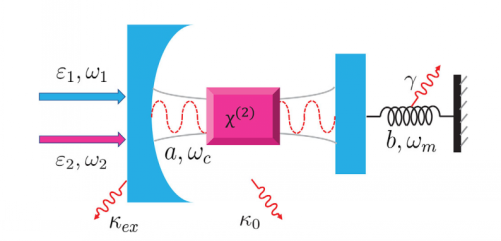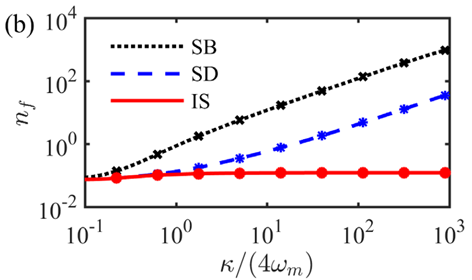Recently, a group led by Associate Professor Yong-Chun Liu from Tsinghua University proposed an intracavity-squeezed optomechanical cooling method to break the quantum backaction limit for ground-state cooling of mechanical resonators. The scheme enables ground state cooling of macroscopic mechanical resonators, which provides the opportunity for quantum manipulation of macroscopic objects with state-of-the-art technology. The research has been published in Laser & Photonic Review entitling “Intracavity squeezed optomechanical cooling” (DOI: 10.1002/lpor.201900120).
Quantum manipulation of macroscopic objects is a persistent goal in quantum science and related application fields. An essential prerequisite to observe quantum phenomenon concerns cooling, that is, reducing the random thermal motional energy. In the past half century, the development of various cooling methods has revolutionized the field of atomic physics. In recent years, the study of macroscopic mechanical resonators in the quantum regime has emerged as an important new frontier with extensive potential applications in quantum information, quantum-limited measurement, and fundamental test of quantum mechanics. Ground-state cooling of mechanical resonators can be realized using cavity optomechanical systems with a laser driving the red mechanical sideband. However, because of quantum backaction, a pure quantum effect originating from the counter-rotating-wave interaction between optical photons and mechanical phonons, the conventional method is only valid in sideband resolved regime (sideband resolved limit), i.e. the cavity dissipation is much smaller than the mechanical eigen frequency. But for real experimental setup, this condition is hard to reach, especially for macroscopic mechanical oscillators which have low resonate frequencies.

Figure 1: Schematic description of the model.
To settle these problems, the research group proposed to achieve ground state cooling with intracavity squeezed scheme. Researchers put a second order nonlinear medium in the conventional optomechanical system as depicted by Figure 1. By introducing nonlinear medium, the cavity light can be strongly squeezed, which facilitates quantum noise interference for all the dissipation channels including both the external and intrinsic cavity dissipations. As a result, the quantum backaction heating effect associated with the cavity dissipations can be fully removed, the resulting cooling limit is no longer dependent upon the sideband resolution.
By comparing with the sideband cooling method (SB) and squeezed driving method (SD), it is found that the proposed intracavity-squeezed cooling method (IS) possesses the lowest cooling limit, which is no longer restricted by the cavity dissipation, revealing a totally removal of quantum backaction heating. The proposed method lays the foundation for ground state cooling of macroscopic mechanical resonators.

Figure 2: Cooling limit versus cavity dissipation for three different cooling methods.
Research link:https://onlinelibrary.wiley.com/doi/full/10.1002/lpor.201900120